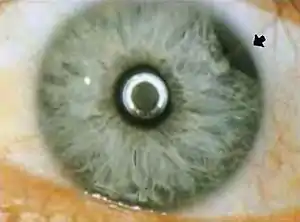Iridodialysis
Iridodialysis, is a localized separation or tearing away of the iris from its attachment to the ciliary body.[1][2]
| Iridodialysis | |
|---|---|
| Other names | Coredialysis |
 | |
| Iridodialysis caused by blunt trauma to the eye | |
| Specialty | Ophthalmology |
Symptoms and signs
Those with small iridodialyses may be asymptomatic and require no treatment, but those with larger dialyses may have corectopia or polycoria and experience monocular diplopia, glare, or photophobia.[3][4][5] Iridodialyses often accompany angle recession[6] and may cause glaucoma[7] or hyphema.[8] Hypotony may also occur.[9]
Complications
Those with traumatic iridodialyses (particularly by blunt trauma) are at high risk for angle recession, which may cause glaucoma.[3] This is typically seen about 100 days after the injury, and as such is sometimes called "100-day glaucoma". Medical or surgical treatment to control the IOP may be required if glaucoma is present.[7] Soft, opaque contact lenses may be used to improve cosmesis and reduce the perception of double vision.[7][3]
Causes
Iridodialyses are usually caused by blunt trauma to the eye,[2] but may also be caused by penetrating eye injuries.[7] An iridodialysis may be an iatrogenic complication of any intraocular surgery[10][11][12] and at one time they were created intentionally as part of intracapsular cataract extraction.[13] Iridodialyses have been reported to have occurred from boxing,[14] airbag deployments,[15] high-pressure water jets,[16] elastic bungee cords,[17][18] bottle caps opened under pressure,[19] water balloons,[20] fireworks,[21][22] and various types of balls.[23]
Treatment
Iridodialysis causing an associated hyphema has to be carefully managed, and recurrent bleeds should be prevented by strict avoidance of all sporting activities. Management typically involves observation and bed rest. Red blood cells may decrease the outflow of aqueous humor, therefore the eye pressure should be kept low by giving oral acetazolamide (a diuretic given to reduce intraoccular pressure). Accidental trauma during sleep should be prevented by patching with an eye shield during night time. Avoid giving aspirin, heparin/warfarin and observe daily for resolution or progression. A large hyphema may require careful anterior chamber washout. Rebleeds may require additional intervention and therapy.
Later, surgical repair may be considered for larger avulsions causing significant double vision, cosmesis or glare symptoms.[4] Surgical repair is usually done by 10-0 prolene suture taking the base of iris avulsion and suturing it to the scleral spur and ciliary body junction.
See also
References
- Cline D; Hofstetter HW; Griffin JR. Dictionary of Visual Science. 4th ed. Butterworth-Heinemann, Boston 1997. ISBN 0-7506-9895-0
- Cassin, B. and Solomon, S. Dictionary of Eye Terminology. Gainesville, Florida: Triad Publishing Company, 1990.
- Rappon JM. "Ocular Trauma Management for the Primary Care Provider." Pacific University College of Optometry. Accessed October 12, 2006. Archived September 1, 2006, at the Wayback Machine
- "Cornea & External Diseases: Trauma: Traumatic Iridodialysis." Archived 2017-10-18 at the Wayback Machine Digital Reference of Ophthalmology. Accessed October 11, 2006.
- Brown, SM (1998). "A technique for repair of iridodialysis in children". Journal of AAPOS. 2 (6): 380–2. doi:10.1016/S1091-8531(98)90041-6. PMID 10532731.
- Sullivan BR. "Glaucoma, Angle Recession". eMedicine.com. August 16, 2006. Accessed October 11, 2006.
- "Glaucoma: Angle Closure: Traumatic Iridodialysis." Archived 2017-05-31 at the Wayback Machine Digital Reference of Ophthalmology. Accessed October 11, 2006.
- Kiel, J; Chen, S (2001). "Contusion injuries and their ocular effects" (PDF). Clinical & Experimental Optometry. 84 (1): 19–25. doi:10.1111/j.1444-0938.2001.tb04931.x. PMID 12366340. Archived from the original (PDF) on 2006-09-27. Retrieved 2006-10-11.
- Behndig, A. (2002). "Results with a modified method for scleral suturing of intraocular lenses". Acta Ophthalmologica Scandinavica. 80 (1): 16–18. doi:10.1034/j.1600-0420.2002.800104.x. PMID 11906298.
- "Manual Small Incision Cataract Surgery: Intraoperative Complications." Archived 2012-02-05 at the Wayback Machine ORBIS International Inc. Accessed October 11, 2006.
- Gashau, AG; Anand, A; Chawdhary, S (2006). "Hydrophilic acrylic intraocular lens exchange: Five-year experience". Journal of Cataract and Refractive Surgery. 32 (8): 1340–4. doi:10.1016/j.jcrs.2006.02.062. PMID 16863972.
- Walker, NJ; Foster, A; Apel, AJ (2004). "Traumatic expulsive iridodialysis after small-incision sutureless cataract surgery". Journal of Cataract and Refractive Surgery. 30 (10): 2223–4. doi:10.1016/j.jcrs.2004.03.040. PMID 15474840.
- Beetham, WP. (1941). "Cataract Extraction with Iridodialysis". Trans. Am. Ophthalmol. Soc. 39: 104–15. PMC 1315004. PMID 16693243.
- Hazar, M; Beyleroglu, M; Subasi, M; Or, M (2002). "Ophthalmological findings in elite amateur Turkish boxers". British Journal of Sports Medicine. 36 (6): 428–30. doi:10.1136/bjsm.36.6.428. PMC 1724577. PMID 12453836.
- Kenney, KS; Fanciullo, LM (2005). "Automobile air bags: friend or foe? A case of air bag-associated ocular trauma and a related literature review". Optometry. 76 (7): 382–6. doi:10.1016/j.optm.2005.06.001. PMID 16038865.
- Gracner, B; Pahor, D (2001). "Bilateral eye injury caused by a high-pressure water jet from a fire hose". Wiener Klinische Wochenschrift. 113 Suppl 3: 62–4. PMID 15503624.
- Viestenz, A; Küchle, M (2002). "Ocular contusion caused by elastic cords: a retrospective analysis using the Erlangen Ocular Contusion Registry". Clinical & Experimental Ophthalmology. 30 (4): 266–9. doi:10.1046/j.1442-9071.2002.00529.x. PMID 12121366.
- Chorich Lj, 3rd; Davidorf, FH; Chambers, RB; Weber, PA (1998). "Bungee cord-associated ocular injuries". American Journal of Ophthalmology. 125 (2): 270–2. doi:10.1016/S0002-9394(99)80111-1. PMID 9467466.
- Viestenz, A; Küchle, M (2002). "Eye contusions caused by a bottle cap. A retrospective study based on the Erlangen Ocular Contusion Register (EOCR)". Der Ophthalmologe. 99 (2): 105–8. doi:10.1007/s003470100504. PMID 11871070.
- Bullock, JD; Ballal, DR; Johnson, DA; Bullock, RJ (1997). "Ocular and orbital trauma from water balloon slingshots. A clinical, epidemiologic, and experimental study". Ophthalmology. 104 (5): 878–87. doi:10.1016/s0161-6420(97)30218-8. PMID 9160038.
- Arya, SK; Malhotra, S; Dhir, SP; Sood, S (September 2001). "Ocular fireworks injuries. clinical features and visual outcome". Indian Journal of Ophthalmology. 49 (3): 189–90. PMID 15887729.
- Sacu, S; Ségur-Eltz, N; Stenng, K; Zehetmayer, M (2002). "Ocular firework injuries at New Year's eve". Ophthalmologica. 216 (1): 55–9. doi:10.1159/000048298. PMID 11901290.
- Purdie, AT; Whyte, IF (1998). "Shinty and ocular trauma in north west Scotland". British Journal of Ophthalmology. 82 (12): 1445. doi:10.1136/bjo.82.12.1444a. PMC 1722457. PMID 9930282.